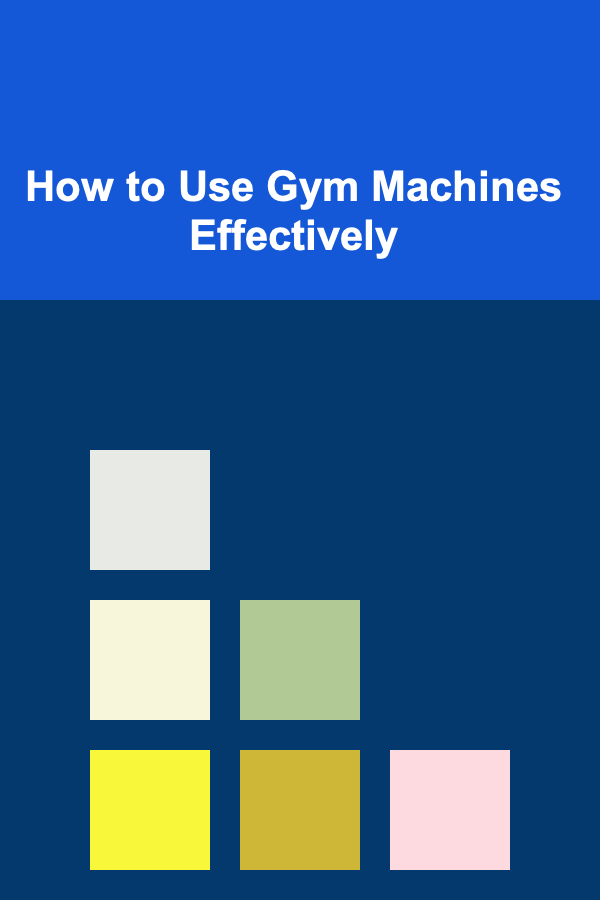
How to Use Gym Machines Effectively
ebook include PDF & Audio bundle (Micro Guide)
$12.99$10.99
Limited Time Offer! Order within the next:

Using gym machines effectively can significantly enhance your fitness routine, helping you achieve your health goals, whether you're aiming to build muscle, lose fat, or improve your overall strength. These machines offer a convenient way to target specific muscle groups, and their design can guide your movements to ensure proper form. However, to truly make the most of your time at the gym, it's essential to understand how to use them correctly, avoid common mistakes, and incorporate them effectively into your training regimen.
In this article, we will explore the benefits and drawbacks of gym machines, discuss how to use them properly, and provide insights on how to create a well-rounded workout routine.
Benefits of Gym Machines
Gym machines offer a number of advantages over free weights, making them an appealing choice for many individuals. Understanding these benefits can help you make an informed decision on how to integrate them into your training program.
1. Guided Movements
One of the main advantages of gym machines is that they offer a guided movement pattern. Unlike free weights, where the lifter has to stabilize the weight and control the direction of movement, gym machines generally only allow movement in one plane. This makes them beginner-friendly, especially for those new to strength training or those recovering from an injury. The fixed path of motion helps minimize the risk of injury by reducing the need for complex stabilization, thus allowing you to focus on the targeted muscle group.
2. Safety
Gym machines are typically safer for beginners compared to free weights, particularly when lifting heavier weights. Because the machine restricts your movement to a controlled range, the chances of performing an unsafe lift are significantly reduced. Additionally, some machines have built-in safety features, such as adjustable weight stacks, which allow you to easily modify the resistance without needing a spotter.
3. Muscle Isolation
Machines are excellent tools for isolating specific muscles. For example, the leg press isolates the quadriceps, hamstrings, and glutes, while the chest press machine targets the chest and triceps. This ability to focus on one muscle group at a time allows for a more precise training approach and can be beneficial when trying to correct muscle imbalances or focus on a particular area for improvement.
4. Variety of Exercises
Gym machines offer a wide variety of exercises for different muscle groups. With machines dedicated to arms, legs, back, and core, there is an abundance of options to create a balanced workout plan. This variety is especially helpful for those looking to add diversity to their workout or avoid plateauing by continually challenging their muscles with new stimuli.
5. Ease of Use
Using gym machines is straightforward, as they typically come with clear instructions on how to adjust the settings and use them properly. The user-friendly nature of most machines makes them accessible to individuals of all fitness levels. Furthermore, machines can often be more comfortable to use than free weights, as they do not require as much skill or coordination, making them an appealing option for people with joint pain or mobility issues.
Drawbacks of Gym Machines
While gym machines have numerous benefits, they also come with certain drawbacks that should be considered when developing your fitness program.
1. Limited Range of Motion
One of the key disadvantages of gym machines is their limited range of motion. Machines are designed with a fixed path of movement, which means they do not allow for the natural, functional movement patterns that you would use in real-life situations or with free weights. This can limit the development of full-range strength and flexibility in some individuals.
2. Lack of Stabilization
Because gym machines guide your movement and provide support, they do not engage your stabilizer muscles to the same extent as free weights. Stabilizer muscles are essential for improving balance, coordination, and overall functional strength. Over-reliance on gym machines can result in underdeveloped stabilizer muscles, which may affect your ability to perform exercises in other settings, such as sports or functional activities.
3. Imbalanced Muscle Development
When using gym machines, it's easy to fall into the trap of only targeting certain muscle groups. Machines typically isolate one muscle group at a time, and if you focus exclusively on these machines, you may neglect other important areas of your body. For instance, you might over-develop your quads by using the leg press but neglect your hamstrings or glutes. A well-rounded workout routine should include exercises that target multiple muscle groups, such as compound lifts.
4. Dependency on Machines
If you rely too heavily on gym machines, you may become overly dependent on them and fail to develop the skills necessary to perform bodyweight or free-weight exercises. This lack of versatility can limit your overall fitness progress and may make it difficult for you to transition to different types of exercises outside the gym machine environment.
How to Use Gym Machines Effectively
To get the most out of your gym machine workouts, you need to use them correctly. Below are some tips to help you maximize the effectiveness of these machines:
1. Adjust the Settings Properly
Before using any machine, make sure that it is set up for your body size and structure. This is one of the most common mistakes people make when using gym machines. If the seat, backrest, or weight stack is not properly adjusted, you risk performing the exercise incorrectly, which could lead to poor form or injury.
How to adjust:
- Seat Position: Adjust the seat so that your joints are aligned properly. For example, when using the leg press machine, your knees should be at a 90-degree angle when your feet are on the platform.
- Handlebars: If the machine involves handlebars, ensure they are at a comfortable height, so your arms are not straining.
- Weight Stack: Select a weight that challenges your muscles without compromising your form. Start with lighter weights and gradually increase resistance as you get stronger.
2. Focus on Proper Form
One of the benefits of gym machines is that they guide your movements, but it is still important to maintain good form. Poor form can lead to injuries and can limit the effectiveness of your workout. Pay attention to the instructions provided by the machine, and always keep your movements controlled. Avoid jerking or swinging the weights, as this can strain your muscles and joints.
3. Perform Full Range of Motion
Even though gym machines guide your movements, it's important to ensure you're using the full range of motion in each exercise. This means extending and contracting your muscles completely throughout the entire movement. Partial range of motion exercises might reduce the effectiveness of the workout, as they do not fully engage the muscle fibers.
4. Incorporate Machines into a Balanced Routine
To get the most benefit from gym machines, incorporate them into a well-rounded workout routine that includes free-weight exercises, bodyweight movements, and cardiovascular activities. Focus on compound exercises (e.g., squats, deadlifts) with free weights and supplement with machine exercises that target specific muscle groups.
5. Don't Overuse Machines
As mentioned earlier, over-relying on gym machines can lead to muscle imbalances and a lack of functional strength. Aim to use machines for isolation exercises, such as leg curls, chest presses, and lat pulldowns, but balance this with other forms of training that engage your stabilizer muscles and promote overall functional strength.
6. Progress Gradually
As with any exercise, it's important to progress gradually when using gym machines. Increase the resistance and difficulty of the exercises over time to challenge your muscles and encourage growth. Sudden increases in weight can lead to injury, so be sure to progress slowly and listen to your body.
7. Incorporate Cardiovascular Machines
In addition to resistance training, cardio machines such as treadmills, ellipticals, and stationary bikes can help improve cardiovascular health. These machines offer a low-impact way to perform aerobic exercises, especially beneficial for individuals with joint pain or those new to fitness.
Creating a Workout Plan with Gym Machines
An effective workout plan should target all the major muscle groups and include both compound and isolation exercises. Here's a sample gym machine-based workout plan for beginners:
Upper Body
- Chest Press Machine -- 3 sets of 10-12 reps
- Lat Pulldown Machine -- 3 sets of 10-12 reps
- Shoulder Press Machine -- 3 sets of 10-12 reps
- Bicep Curl Machine -- 3 sets of 10-12 reps
- Tricep Extension Machine -- 3 sets of 10-12 reps
Lower Body
- Leg Press Machine -- 3 sets of 10-12 reps
- Leg Curl Machine -- 3 sets of 10-12 reps
- Leg Extension Machine -- 3 sets of 10-12 reps
- Calf Raise Machine -- 3 sets of 10-12 reps
Core
- Ab Crunch Machine -- 3 sets of 12-15 reps
- Rotary Torso Machine -- 3 sets of 12-15 reps
Remember to adjust the weight and machine settings to match your fitness level, and always listen to your body to avoid overexertion.
Conclusion
Using gym machines effectively can be a great way to achieve your fitness goals, whether you're a beginner or an experienced athlete. By focusing on proper form, adjusting the machines correctly, and integrating them into a balanced routine, you can maximize the benefits of machine-based training. However, it's important to remember that machines should be part of a diverse workout program that includes free weights, bodyweight exercises, and cardiovascular activities to ensure well-rounded fitness and prevent imbalances.
Reading More From Our Other Websites
- [Home Renovating 101] How to Update Your Kitchen Hardware: Trends and Tips for a Modern Look
- [Home Renovating 101] How to Create a Custom Closet During Your Home Renovation
- [Mindful Eating Tip 101] Mindful Choices on the Menu: Tips for Conscious Eating at Any Eatery
- [Home Renovating 101] How to Make the Most of Your Home Renovation Timeline
- [Home Cleaning 101] How to Clean Your Home Efficiently on a Tight Schedule
- [Home Budget Decorating 101] How to Choose Affordable Artwork for Your Walls
- [Home Space Saving 101] How to Transform Your Medicine Cabinet into an Organization Masterpiece: Decluttering for Optimal Space
- [Home Lighting 101] How to Light Your Home for a Cozy, Welcoming Atmosphere
- [Home Pet Care 101] How to Get Your Cat to Drink More Water: Tips for Hydration
- [Organization Tip 101] How Smart Faucets Are Revolutionizing Home Water Systems

Creating AI Products for Passive Income with Deep Learning
Read More
How to Advocate for Climate-Smart Urban Planning
Read More
How to Incorporate Vintage Charm in Your Home Renovation
Read More
How to Organize Your DVD Collection with Style
Read More10 Tips for Tracking Progress with Your Public Speaking Planner
Read More
How to Build a Content Planner That Adapts to Changing Algorithms
Read MoreOther Products

Creating AI Products for Passive Income with Deep Learning
Read More
How to Advocate for Climate-Smart Urban Planning
Read More
How to Incorporate Vintage Charm in Your Home Renovation
Read More
How to Organize Your DVD Collection with Style
Read More10 Tips for Tracking Progress with Your Public Speaking Planner
Read More